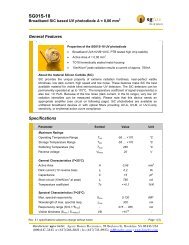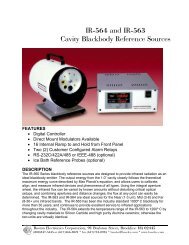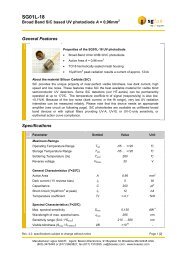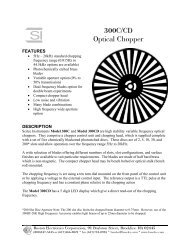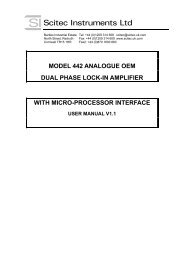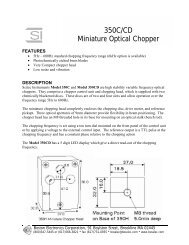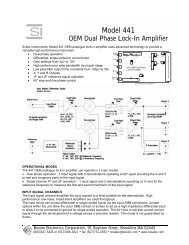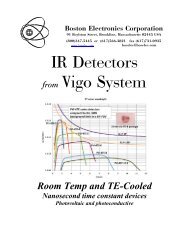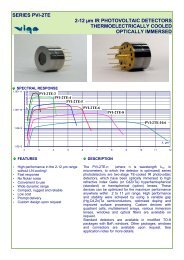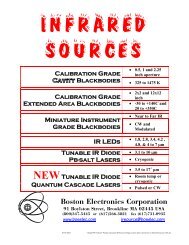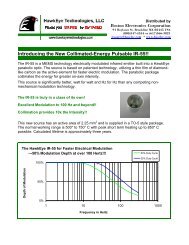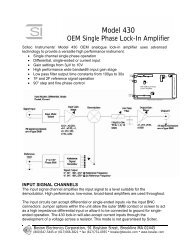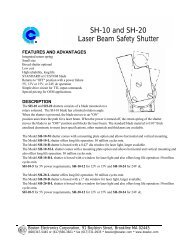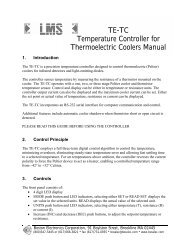TCSPC for FLIM and FRET in - Boston Electronics Corporation
TCSPC for FLIM and FRET in - Boston Electronics Corporation
TCSPC for FLIM and FRET in - Boston Electronics Corporation
You also want an ePaper? Increase the reach of your titles
YUMPU automatically turns print PDFs into web optimized ePapers that Google loves.
the ‘figure of merit’ [39] as a function of the detector count rate <strong>for</strong> different techniques are shown<strong>in</strong> fig. 38. The values <strong>for</strong> the image <strong>in</strong>tensifiers <strong>and</strong> s<strong>in</strong>gle channel nmodulation techniques weretaken from [39], the value <strong>for</strong> multi-gate photon count<strong>in</strong>g from [81].1Efficiency0.8<strong>TCSPC</strong>, 1 ChannelModulation<strong>TCSPC</strong>, 4 Channels4FFigureof Merit3.43.2Image IntensifiersModulation0.632.80.4Multi Gate SPC2.62.42.220.21.81.6Multi Gate SPC<strong>TCSPC</strong>, 4 Channels010 kHzModulationImage Intensifiers100 kHz1 MHz10 MHzDetector Count Rate1.41.2110 kHzModulation100 kHz<strong>TCSPC</strong>, 1 Channel1 MHz10 MHzDetector Count RateFig. 38: Count<strong>in</strong>g efficiency <strong>and</strong> figure of merit F of <strong>TCSPC</strong> imag<strong>in</strong>g compared to other techniquesF is the ratio of theoretical SNR to obta<strong>in</strong>ed SNR, F=1 means ideal SNRSurpris<strong>in</strong>gly, <strong>TCSPC</strong> imag<strong>in</strong>g beats the other methods even <strong>for</strong> detector count rates of the order of 5to 10 MHz.It is unlikely that such high count rates can be obta<strong>in</strong>ed from liv<strong>in</strong>g cells. Anyway, a count rateabove 5 MHz imposes overload problems to most detectors. Although traditional PMTs still work at10 MHz the tim<strong>in</strong>g per<strong>for</strong>mance may not longer meet the high st<strong>and</strong>ard of the <strong>TCSPC</strong> method.MCP PMTs, i.e. the fastest detectors <strong>for</strong> <strong>TCSPC</strong>, are clearly overloaded above 1 MHz. If a system isto be operated at extremely high count rates the solution is the multidetector technique. If the lightis split <strong>in</strong>to several detection channels the load <strong>for</strong> the <strong>in</strong>dividual detectors is reduced.Another solution is to operate several <strong>TCSPC</strong> modules with <strong>in</strong>dividual detectors <strong>in</strong> parallel.Although no such application has become known yet the implementation is straight<strong>for</strong>ward. TheBecker & Hickl <strong>TCSPC</strong>s are designed to work <strong>in</strong> packages of up to four devices [63].The acquisition time <strong>for</strong> <strong>TCSPC</strong> lifetime measurements can vary <strong>in</strong> a wide range. In vivo lifetimemeasurements at the human ocular fundus <strong>in</strong> conjunction with an ophthalmologic scanner delivereds<strong>in</strong>gle exponential lifetimes <strong>for</strong> an array of 128x128 pixels with<strong>in</strong> a few seconds [75, 75b]. On theother h<strong>and</strong>, <strong>for</strong> the double exponential decay data of <strong>FRET</strong> measurements acquisition times from 5to 30 m<strong>in</strong>utes were used [68].In practice the acquisition time depends on the required lifetime accuracy, on the number oflifetime components to be resolved, on the number of pixels <strong>and</strong> wavelength channels <strong>and</strong> on thecount rate that can be obta<strong>in</strong>ed from the sample without photobleach<strong>in</strong>g or photodamage. Fig. 39shows the acquisition time as a function of the product of the number of pixels <strong>and</strong> the number ofwavelength channels. The left diagram is <strong>for</strong> a high count rate of 10 6 /s. Count rates of this order canbe obta<strong>in</strong>ed by one-photon excitation from cells conta<strong>in</strong><strong>in</strong>g high chromophore concentrations. Fortwo-photon excitation a count rate of 10 6 /s requires extremely stable samples sta<strong>in</strong>ed with veryefficient chromophores.The right diagram is <strong>for</strong> a very low count rate of 10 4 /s. Count rates of this order are typical <strong>for</strong>autofluorescence of cells <strong>and</strong> tissue <strong>and</strong> <strong>for</strong> samples with low photostability. An HEK cell33



